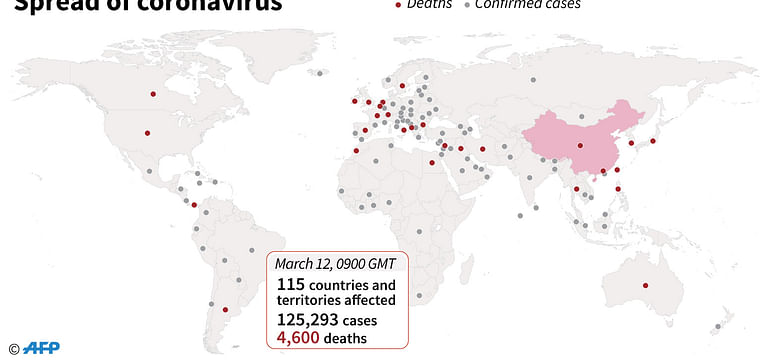

Health workers pull out a capsule to treat patients infected with coronavirus (Covid19) towards an ambulance outside the XE Medica, a company which provides medical equipment and services, in Mexico City, Mexico 10 March , 2020.
The World Health Organization has declared the coronavirus outbreak as a pandemic. The virus, also known as COVID-19, has reached 114 countries, infected more than 118,000 people and killed 4,291 as of 12 March 2020. The virus is spreading steadily and despite strict health measures, the virus has a high probability infecting of more and more people. It is threatening global economy and heath, both of which may collapse in the coming days.
Following the declaration of COVID-19 as a pandemic, António Guterres, current secretary general of the United Nations said the declaration of the ‘COVID19 pandemic is a call to action – for everyone, everywhere.’
António Guterres✔@antonioguterresToday’s declaration of a #COVID19 pandemic is a call to action – for everyone, everywhere.It’s also a call for responsibility & solidarity – as nations united and as people united.As we fight the virus, we cannot let fear go viral.Let’s overcome this common threat together.
“It’s also a call for responsibility and solidarity – as nations united and as people united. As we fight the virus, we cannot let fear go viral,” Guterres tweeted on 12 March.
It is not the first flu pandemic the humans have experienced. In the past, viruses have wiped out millions of people through several plagues, epidemics and pandemics.
Some most lethal pandemics of the recent times are described here in brief.
Spanish Flu Pandemic
The 1918 influenza pandemic was the deadliest flu outbreak in recent human history. The H1N1, also called Spanish Flu, killed millions of people across the globe.
According to the Centers for Disease Control and Prevention, the leading national public health institute of the United States, the 1918 pandemic was caused by an H1N1 virus with genes of avian origin. The virus spread worldwide between 1918 and 1919. As many as 500 million people, one-third of the world’s population, were infected with infected with this virus. The virus killed approximately 50 million worldwide and around 675,000 people in the United States alone.
HIV/AIDS Pandemic
In terms of the time, HIV/AIDS may be the largest pandemic in the human history. After four decades of it emergence, the virus is still infecting and killing a large number of people. As per the CDC, the first cases of acquiring immunodeficiency syndrome (AIDS) were reported in 1981.
Human immunodeficiency virus (HIV) then grown to pandemic and it has so far infected 65 million and killed 25 million. US government statistics show 1.1 million are living with HIV in the country alone and about 38,000 new HIV infections still occur in the United States each year.
Another statistics said the death toll would be at least 36 million.
Swine Flu Pandemic
The novel virus Swine Flu is similar to the H1N1. It was first detected in the US in 2009, and spread quickly across the world.
CDC estimated that 151,700-575,400 people worldwide died from (H1N1)pdm09 virus infection in its first year. According to the CDC, between April 2009 and April 2010, 60.8 million were diagnosed with the virus and 12,469 deaths were reported. The CDC also estimated that the virus killed up to 575,400 people globally.
Asian Flu Pandemic
H2N2, also called Asian flu, was first reported in Singapore in February 1957, Hong Kong in April 1957. Then it took the world tour. As per CDC, it spanned between 1957 and 1958. The H2N2 virus was comprised of three different genes from an H2N2 virus that originated from an avian influenza A virus. The estimated number of deaths was 1.1 million worldwide and 116,000 in the United States.
The virus broke out in two phases. In the wave, the virus spread throughout China, then into the United States, England. It killed 14,000 people in England alone in just six months. The phase broke out in early 1958, and turned into a pandemic claiming around 1.1 million globally.
Hong Kong Flu Pandemic
Hong Kong Flu, also known as H3N2, was a category 2 Flu pandemic. It was first reported in July 1968 outside the mainland China. Scientists identified the virus as H3N2. The virus killed one million people worldwide and 100,000 in the United States alone.
Though the 1968 pandemic had a comparatively low mortality rate (.5%), it still resulted the deaths of more than a million people. It wiped out 500,000 residents of Hong Kong, meaning 15% of its population at the time.












0 comments:
Post a Comment